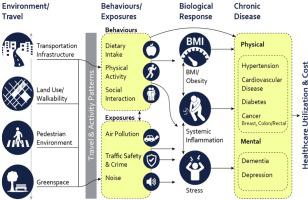Environment International ( IF 11.8 ) Pub Date : 2021-11-09 , DOI: 10.1016/j.envint.2021.106959 Lawrence D Frank 1 , Binay Adhikari 2 , Katherine R White 2 , Trevor Dummer 3 , Jat Sandhu 4 , Ellen Demlow 5 , Yumian Hu 5 , Andy Hong 6 , Matilda Van den Bosch 2

|
Background
Diabetes is among the most prevalent non-communicable diseases causing significant morbidity and mortality globally. The aetiology and disease development of diabetes are influenced by genetic, lifestyle, and environmental factors. Due to an increasing number of cases each year, it is imperative to improve the understanding of modifiable environmental risk and protective factors. In this study we aimed to analyse associations between built and natural environment features and diabetes prevalence; and two major risk factors: physical activity and obesity and their mediation effects.
Methods
We analysed relationships between walkability and park availability with physical activity, obesity, and diabetes, using self-reported data from a large cross-sectional survey in British Columbia, Canada (n = 22,418). We validated results with an independent cohort (n = 11,972) in a subset of the analyses. The outcome measures included walking, moderate to vigorous physical activity (MVPA), body mass index (BMI), and diabetes. Built and natural environment features within a 1 km road network buffer around residential postal code centroids were assessed using validated indicators of walkability and park availability. We used general linear multivariable models (GLM) to examine the direct relationship between environmental features, physical activity, obesity, and diabetes respectively. Path models were developed to analyse mediation effects of physical activity and obesity on the association between environmental indicators and diabetes. The relative contribution of direct versus indirect effects was assessed. All models were adjusted for age, gender, income. ethnicity, years lived in neighbourhood and regional accessibility.
Results
Walkable neighbourhoods and areas with greater park availability were associated with lower rates of diabetes. There was a direct association of walkability and park availability on physical activity (highest vs. lowest quintile OR = 1.15; 95% CI: 1.00, 1.33 and OR = 1.28, 95% CI: 1.13, 1.45 respectively), obesity (highest vs. lowest quintile OR = 0.58, 95% CI: 0.49, 0.70 and OR = 0.57, 95% CI: 0.48, 0.68 respectively) and diabetes (highest vs. lowest quintile OR = 0.62, 95% CI: 0.45, 0.85, and OR = 0.63, 95% CI: 0.47, 0.84 respectively). Results were similar in the independent cohort. The associations between diabetes and walkability and park availability respectively were partly mediated by obesity (41% of total association for walkability and 53% of total association for park availability). The mediating effect of physical activity was negligible.
Conclusion
Results support investments in walkability through active transportation and transit infrastructure. Changes in zoning and subdivision regulations governing land use actions are required to enable compact mixed-use environments with access to parks and high quality transit service. Future studies including cost-benefit analyses of health-related economic impacts of such investments can contribute to evidence-based decisions for healthier cities.
中文翻译:

慢性病和居住地:建筑和自然环境与身体活动、肥胖和糖尿病的关系
背景
糖尿病是最普遍的非传染性疾病之一,在全球范围内导致严重的发病率和死亡率。糖尿病的病因和疾病发展受遗传、生活方式和环境因素的影响。由于每年的病例数量都在增加,因此必须提高对可改变的环境风险和保护因素的认识。在这项研究中,我们旨在分析建筑和自然环境特征与糖尿病患病率之间的关联;和两个主要风险因素:体力活动和肥胖及其中介效应。
方法
我们使用来自加拿大不列颠哥伦比亚省 (n = 22,418) 的大型横断面调查的自我报告数据,分析了步行性和公园可用性与体育活动、肥胖和糖尿病之间的关系。我们在部分分析中使用独立队列 (n = 11,972) 验证了结果。结果测量包括步行、中度至剧烈的体力活动 (MVPA)、体重指数 (BMI) 和糖尿病。使用经过验证的步行性和公园可用性指标评估住宅邮政编码质心周围 1 公里道路网络缓冲区内的建筑和自然环境特征。我们使用一般线性多变量模型 (GLM) 分别检查环境特征、身体活动、肥胖和糖尿病之间的直接关系。开发路径模型来分析身体活动和肥胖对环境指标与糖尿病之间关联的中介作用。评估了直接与间接影响的相对贡献。所有模型都针对年龄、性别、收入进行了调整。种族、居住年限和区域可达性。
结果
可步行的社区和拥有较多公园的地区与较低的糖尿病发病率相关。可步行性和公园可用性与身体活动(最高与最低五分之一 OR = 1.15;95% CI:1.00、1.33 和 OR = 1.28、95% CI:1.13、1.45)、肥胖(最高与最低五分之一)直接相关。最低五分位数 OR = 0.58, 95% CI: 0.49, 0.70 和 OR = 0.57, 95% CI: 0.48, 0.68 和糖尿病(最高与最低五分位数 OR = 0.62, 95% CI: 0.45, 0.85 和 OR = 0.63、95% CI:分别为 0.47、0.84)。独立队列的结果相似。糖尿病与步行能力和公园可用性之间的关联分别部分由肥胖介导(步行能力总关联的 41% 和公园可用性总关联的 53%)。
结论
结果支持通过积极的交通和交通基础设施对步行性进行投资。需要改变管理土地使用行动的分区和细分法规,以实现紧凑的混合用途环境,进入公园和高质量的交通服务。未来的研究,包括对此类投资的健康相关经济影响的成本效益分析,有助于为更健康的城市做出基于证据的决策。



























 京公网安备 11010802027423号
京公网安备 11010802027423号